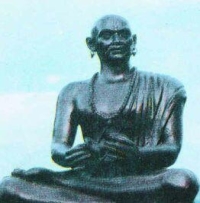Kshetrayya (c. 1600 – 1680) was a prolific Telugu poet and composer of Carnatic music. He lived in the area of Andhra Pradesh in South India. He composed a number of padams and keertanas, the prevalent formats of his time. He is credited with more than 4000 compositions, although only a handful have survived. He composed his songs on his favourite deity Krishna (Gopala) in Telugu.
Not much is known about his personal life. He was born in a village called Movva (also known as muvva) in Andhra Pradesh. His parents named him Varadayya. Because of his habit of travelling from one place to another singing his songs at various temples, he came to be called Kshetragna or Kshetrayya (one who travels). The life of Kshetragna is depicted in the novel “Bliss Of Life” by Prof M. V Rama Sarma, Professor of English & former Vice chancellor, S.V University, Tirupati, Andhra Pradesh, India. It is also translated into Telugu with the title “Kshetrayya”.
He perfected the padam format that is still being used today. His padams are sung in dance (Bharatanatyam and Kuchipudi) and music recitals. A unique feature of his padams is the practice of singing the anupallavi first then the pallavi (second verse followed by first verse). Most of the padams are of the theme of longing for the coming of the lord Krishna.
He wrote with Sringara as a main theme in expressing madhurabhakti (devotion to the supreme). Sringara is a motif where the mundane sexual relationship between a Nayaki (woman) and a Nayaka (man) is used as a metaphor, denoting the yearning of jeeva (usually depicted as the Nayaki) to unite with the divine (usually depicted as the man). In most of his compositions, Kshetrayya has used the mudra (signature) “Muvva Gopala” as a reference to himself, which is also a name for the Lord Krishna in Kshetrayya’s village Muvva, now called as Movva.
Kshetrayya’s work has played a major role in influencing poetry, dance, music of the South Indian tradition. Kshetrayya was intimately connected with the devadasi women of the temples of south India, who were the subject of many of his compositions. The devadasis were traditionally in possession of the musical/poetic interpretations of his work for a long period of time till the devadasi system was abolished and the compositions became more accepted in the musical community as valuable works of art. The musical community also owes a lot to Veena Dhanammal and T. Brinda, who popularized Kshetrayya’s songs with their beautiful musical interpretation.
Kshetrayya’s padams now form an integral part of the dance and musical traditions of South India, where his songs are rendered purely as musical works or as accompaniments to dance.


No comments yet.